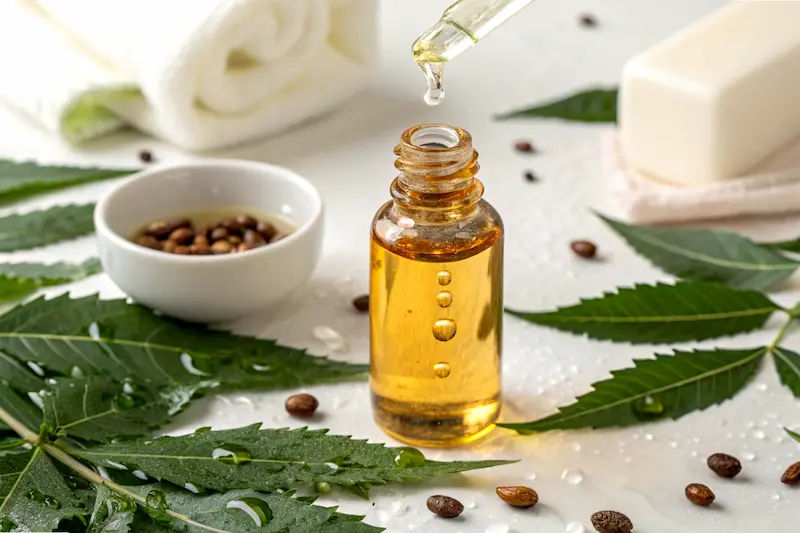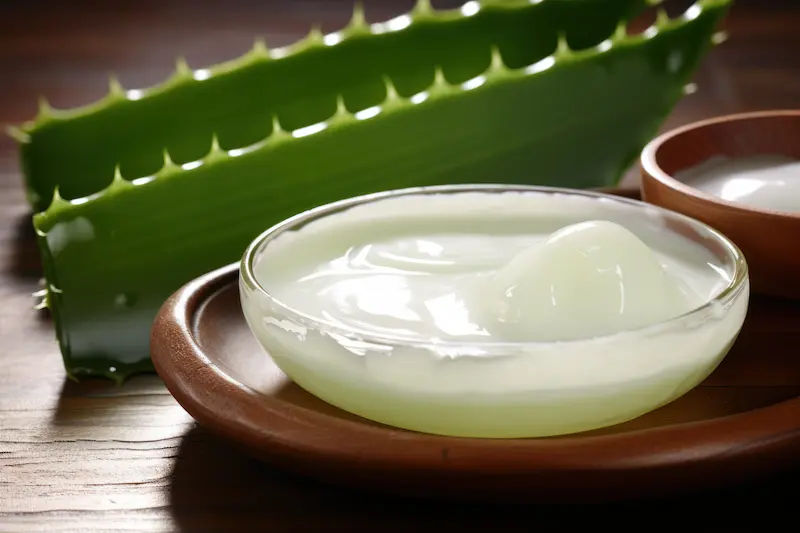Vitamin E Oil Benefits for Skin: How to Use for Glowing Skin?
Discover vitamin E oil benefits for glowing skin. Learn safe, simple skincare tips, who should use it, side effects, and dermatologist-approved guidance.

Written by Dr. Siri Nallapu
Reviewed by Dr. Shaik Abdul Kalam MD (Physician)
Last updated on 20th Nov, 2025

Introduction
If you’re curious about vitamin E oil benefits and how to add them to your skincare routine, you’re not alone. Vitamin E is a well-known antioxidant often found in lotions, serums, and oils. It’s popular because it can help support the skin’s barrier, add moisture, and protect against environmental stress. Still, it’s important to use it the right way for your skin type and to understand what it can and cannot do.
What Is Vitamin E?
• Vitamin E is a group of fat-soluble compounds (most commonly alpha tocopherol) found naturally in foods like nuts, seeds, and vegetable oils. In skincare, vitamin E is used in two main ways:
• As an ingredient in topical products (oils, serums, creams) to help moisturize and protect the skin.
• It is an antioxidant stabilizer that helps protect both your skin and the product itself from oxidation.
Topical vitamin E comes in forms such as tocopherol and tocopheryl acetate. Many moisturizers include small amounts of vitamin E alongside other beneficial ingredients.
Top vitamin E oil benefits for your skin
While individual results vary, research and clinical experience suggest several practical ways vitamin E can support skin health:
Antioxidant support
• Vitamin E helps neutralize free radicals from UV light and pollution. This antioxidant activity can help reduce oxidative stress, which contributes to signs of aging like dullness and dryness. It’s not a sunscreen, but it complements daily sun protection.
Moisturizing and barrier support
• Vitamin E–containing oils and creams can reduce water loss from the skin, helping it feel softer and more supple. This is especially helpful for dry or mature skin. Consult a Top General Physician
Soothing effects for dryness and mild irritation
Many people find vitamin E–containing products soothing on rough, flaky patches. It’s commonly used in products designed to comfort dry skin. If you have a chronic skin condition like eczema, talk with a dermatologist for personalized care; vitamin E can be part of a gentle routine, but is not a stand alone treatment.
Works well with other antioxidants
• Vitamin E is often paired with vitamin C in serums. Together, they offer complementary antioxidant support. This can help protect skin from environmental stressors when used under a daily sunscreen.
What vitamin E cannot promise
• It is not a cure for scars or stretch marks. Evidence for scar reduction is limited, and some people actually develop irritation from applying vitamin E oils to healing skin.
• It does not replace sunscreen. Use a broad spectrum SPF 30 or higher every day.
• It is not a proven acne treatment. Heavy oils may trigger breakouts in acne prone skin.
Who is most likely to benefit?
• Dry or mature skin: Vitamin E–containing moisturizers and oils can help lock in hydration and soften rough areas.
• Sensitive skin: Some people find vitamin E soothing. However, others can react to it, so patch testing is important.
• Sun exposed skin: Vitamin E used with vitamin C and sunscreen can offer additional environmental protection.
Who should be cautious?
• Acne prone or oily skin: Pure oils may feel heavy and can clog pores in some people. Choose lightweight, non comedogenic formulas or moisturizers with vitamin E rather than pure oil.
• People with a history of contact dermatitis or allergies: Vitamin E can irritate some individuals. Always patch tests first.
• Anyone with recent procedures or open wounds: Avoid applying oils or actives to fresh, healing skin unless a healthcare professional advises it.
How to use vitamin E oil in your skincare routine?
Adding vitamin E oil to skincare is simple, but a few steps will help you get the most benefit while minimizing irritation.
Step 1: Patch test
• Apply a pea sized amount of the product to the inner forearm or behind the ear once daily for 2–3 days.
• If you notice redness, itching, stinging, or new bumps, stop using it.
Step 2: Choose the right format
• Pure vitamin E oil: Very rich and occlusive, best for small dry patches or very dry skin. It can feel heavy and may increase breakouts in acne prone skin.
• Serum with antioxidants (vitamin C + E, sometimes with ferulic acid): Designed for daytime use under sunscreen to help defend against environmental stress.
• Moisturizer with vitamin E: A gentler, everyday option that adds hydration without the heaviness of a pure oil.
Step 3: When and how to apply
• Evening use for pure oils: Apply a thin layer as the last step of your nighttime routine, especially over damp skin to seal in moisture.
• Daytime antioxidant serum: If using a serum containing vitamin E, apply after cleansing and before moisturizer and sunscreen. Allow each layer to absorb.
• Keep amounts small: A few drops or a pea sized amount is usually enough to cover the face. More is not better and may increase the risk of irritation or clogged pores.
Step 4: Pair wisely with other actives
• With retinoids: Many people use retinoids at night; you can apply a light moisturizer with vitamin E after your retinoid if your skin tolerates it. If irritation occurs, separate use (e.g., alternate nights).
• With vitamin C: Vitamin C and E work well together in the morning under sunscreen.
• With exfoliating acids: If your skin is sensitive, avoid layering strong acids and pure vitamin E oil in the same routine to reduce the chance of irritation.
Practical tips for success
• Less is more: Start with 2–3 nights per week and increase as tolerated.
• Target trouble spots: Focus on dry areas like the cheeks or around the mouth rather than applying thick oil everywhere.
• Store it well: Keep vitamin E products tightly closed, away from heat and direct light. Discard if the product smells rancid or changes color.
• Mind the eyes: Use eye area products specifically designed for that region. Avoid getting oils in the eyes.
Myths vs. facts about vitamin E and skin
• Myth: “Vitamin E oil erases scars and stretch marks.”
Fact: Research does not support consistent scar improvement from topical vitamin E, and some users develop contact dermatitis. Silicone gel/sheets, sun protection, and time are better supported options. Ask a dermatologist for scar care guidance.
• Myth: “Vitamin E is a sunscreen.”
Fact: Vitamin E helps with oxidative stress but does not provide SPF. Always apply a broad spectrum sunscreen (SPF 30+) daily.
• Myth: “Natural vitamin E can’t irritate skin.”
Fact: Even natural ingredients can cause reactions. Patch testing is still important.
• Myth: “If a little is good, more is better.”
Fact: Overusing heavy oils may clog pores and doesn’t increase benefits. Use the smallest amount that leaves your skin comfortable.
Safety and side effects
Topical use
• Possible reactions: Redness, itching, hives, or acne like bumps (especially with heavy oils).
• Stop and seek advice if you develop swelling, severe itching, widespread rash, or worsening irritation.
Oral supplements (important context)
• Vitamin E supplements are not needed for most healthy adults who eat a balanced diet.
• High dose supplements can increase bleeding risk and interact with blood thinners and some other medications. If you’re considering oral vitamin E for skin or any reason, talk to a healthcare professional first.
• During pregnancy and breastfeeding, topical use in typical cosmetic amounts is generally considered low risk, but consult your clinician before starting new products if you have concerns. Avoid high dose supplements unless medically advised.
A simple skincare routine that includes vitamin E
Morning
• Cleanser (gentle)
• Antioxidant serum with vitamin C + E (optional)
• Moisturizer (if needed)
• Broad spectrum sunscreen SPF 30+ (non negotiable)
Evening
• Cleanser
• Treatment (if using, such as a retinoid, start slowly)
• Moisturizer
• A small amount of vitamin E–containing moisturizer or a drop or two of vitamin E oil if your skin is very dry
How to choose a good vitamin E product?
• Look for ingredient names: tocopherol or tocopheryl acetate.
• Prefer opaque or amber packaging to reduce light exposure.
• Choose reputable brands that list full ingredients.
• Consider your skin type: lighter lotions/gels for oily or acne prone skin; richer creams or oils for dry skin.
• Avoid fragranced products if you’re sensitive.
When to see a dermatologist?
• You have persistent dryness, eczema, or irritation that doesn’t improve with gentle skincare.
• You’re dealing with acne, melasma, or scarring and want evidence based treatments.
• You have a history of allergic reactions to skincare and need help choosing safe products. Consult a Top General Physician
Bottom line
Vitamin E oil benefits can include improved moisturization and added antioxidant support, especially when paired with daily sunscreen and a balanced routine. For most people, using a moisturizer or serum that includes vitamin E is a practical, skin friendly approach. If you’re acne prone or sensitive, start slowly, patch test, and consider lighter formulas. With smart use, vitamin E can be a helpful part of your skincare toolkit, but it isn’t a cure all.
Consult a Top General Physician

Dr. Abhishek Ranjan
General Practitioner
4 Years • MBBS
Kolkata
VDC Clinic, Kolkata

Dr. Soumen Paul
General Physician/ Internal Medicine Specialist
24 Years • MBBS
Kolkata
MCR SUPER SPECIALITY POLY CLINIC & PATHOLOGY, Kolkata
(25+ Patients)

Dr. Santanu Mandal
General Physician/ Internal Medicine Specialist
17 Years • MD (Physician), DNB (General Medicine)
Kolkata
MCR SUPER SPECIALITY POLY CLINIC & PATHOLOGY, Kolkata
(25+ Patients)
Dr. Abhishek Gowda
General Physician/ Internal Medicine Specialist
2 Years • MBBS
Bengaluru
PRESTIGE SHANTHINIKETAN - SOCIETY CLINIC, Bengaluru

Dr. Swagato Podder
General Practitioner
5 Years • MBBS
Kolkata
GRD POLYCLINIC, Kolkata
Consult a Top General Physician

Dr. Abhishek Ranjan
General Practitioner
4 Years • MBBS
Kolkata
VDC Clinic, Kolkata

Dr. Soumen Paul
General Physician/ Internal Medicine Specialist
24 Years • MBBS
Kolkata
MCR SUPER SPECIALITY POLY CLINIC & PATHOLOGY, Kolkata
(25+ Patients)

Dr. Santanu Mandal
General Physician/ Internal Medicine Specialist
17 Years • MD (Physician), DNB (General Medicine)
Kolkata
MCR SUPER SPECIALITY POLY CLINIC & PATHOLOGY, Kolkata
(25+ Patients)
Dr. Abhishek Gowda
General Physician/ Internal Medicine Specialist
2 Years • MBBS
Bengaluru
PRESTIGE SHANTHINIKETAN - SOCIETY CLINIC, Bengaluru

Dr. Swagato Podder
General Practitioner
5 Years • MBBS
Kolkata
GRD POLYCLINIC, Kolkata
More articles from Skin Care
Frequently Asked Questions
1) Can vitamin E oil lighten dark spots or melasma?
Not reliably on its own. Some antioxidant blends (vitamin C + E) may support a brighter look over time when used with daily sunscreen, but targeted treatments from a dermatologist are usually more effective.
2) Does vitamin E oil help scars?
Evidence is mixed and often negative. Many studies show little to no improvement in scars, and some people develop irritation. Silicone gel/sheets, sun protection, and time have better support.
3) Is vitamin E oil good for acne?
It’s not a proven acne treatment, and heavy oils may clog pores for some. If you’re acne prone, choose lightweight, non comedogenic products or ask a dermatologist for acne safe options.
4) Can I apply vitamin E directly from a capsule to my face?
You can, but it’s often very thick and may increase the risk of breakouts or irritation. Many people do better with a well formulated moisturizer or serum containing vitamin E.
5) How often should I use vitamin E in skincare?
Start with 2–3 times per week and increase as tolerated. Many people use a vitamin E–containing product daily, but adjust based on your skin’s response.




